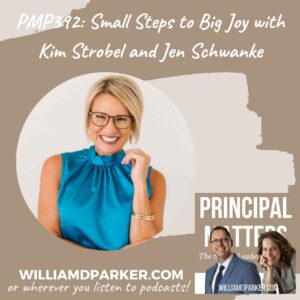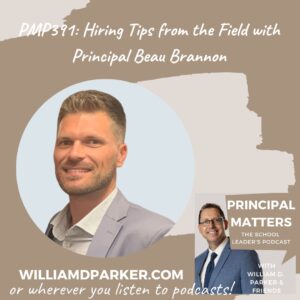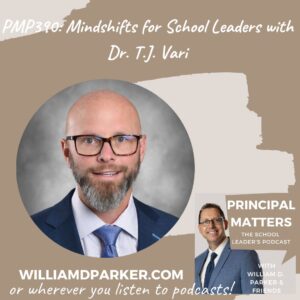Podcast: Play in new window | Download
This morning I was running a three-mile track around my neighborhood.

As I passed the houses and occasional drivers, I felt a sudden kinship to my neighbors I’m not sure I’ve felt before. We don’t just share the same zip-code; we now share a common experience. And this experience spreads beyond our cities and states. We share a common bond across the entire world.
If you think about it, we have only been in this distance learning journey a relatively short time. But it doesn’t feel that way. The first case of COVID-19 worldwide was reported in January. But none of us had any idea what would happen in the ensuing weeks. By early March, U.S. cases had been reported. Washington state was the first to close schools. And as the virus spread into a pandemic, U.S. schools across the nation responded with closures and implementation of distance learning.
In my own state of Oklahoma, March 25 marked the announcement from our Oklahoma State Department of Education that schools would close the rest of the year with distance learning plans beginning April 6. As I write this post on April 10, 2020, my family and I are in our fourth week of safer-at-home activity. And my children are finishing their first week of full-time distance learning lessons from their school.
Just as we all share a common bond with one another worldwide, as leaders, we also share common lessons during these times.
When schools began closing and making plans for distance learning, my calendar quickly filled with Zoom meetings and phone calls from other leaders. As executive director for the Oklahoma Association of Secondary School Principals (an affiliate of the Cooperative Council for Oklahoma School Administration), I have had a front-row seat with leaders across my state.
I also coordinate with other state leaders through NASSP, the National Association of Secondary School Principals. And as a Solution Tree author and speaker, I also have colleagues across the nation and internationally with whom I collaborate.
What lessons am I seeing from leaders during these uncertain times? Here are a five:
1. Relationships still matter now as much as ever.
For principals with small and large school populations, I’m hearing the same feedback: Reach out to your people. Make sure they know you care about them and their safety and well-being. Above all else, assure your teachers, staff and students that you care and want to be available to help however you can.
Chris Legleiter, Principal of Leawood Middle School, Blue Valley Schools, just outside Kansas City, Missouri, talked to me by Zoom and said, “I’ll be honest that is the hardest thing I think for most educators. We are all about relationships, and it took me a few days to really understand those relationships are still there. Now it is all about understanding how do I adjust to still connect with people.”
He explained more, “As the building leader, I have used videos as one way to connect. I spent some time calling families one-on-one by phone. You can still write a note and mail it to someone’s residence. I think connecting relationships are still important, but I think that looks so different now in the virtual world. That’s what I’m trying to stay focused on what I cando, not what I can’t do.”
2. It still takes a team!
Don’t carry the burden alone. Just like a great school functions during normal times, you cannot accomplish your goals without a strong team. Ask for help and reach out to others when you need feedback. Utilize your teachers and staff for reaching students.
Many elementary leaders I talk to are reaching students by using classroom teachers to connect and support students at home. At the secondary level, many principals I know are dividing up their students among PLC teams or Teacher Advisory Teams so that every student is being regularly contacted and supported.
Principal Chris LeGrande, at Guthrie High School, outside of Oklahoma City told me when closures were first announced, he and his two assistant principals divided up the phone numbers of every teacher and staff member in the building. They reached out to them by phone to hear their concerns and assure them of their support. Now that they have transitioned to distance learning, the same conversations happen among teachers and the more than 1,000 high school students in his building.
“I would say the best thing or the most exciting thing to me is the fact that we have required our teachers to reach out to their students to make contact and communicate with all of them,” Mr. LeGrande explained. “I think the overall theme is the fact that the kids just miss school and being around their friends,” he said.
Terrence Simmons, an Assistant Principal at Floyd Elementary, in Nye County, Nevada, told me how they responded as a team. They launched distance learning for their students in three days, and the district website became a resource for parents wanting guidance and digital tools.
Mr. Simmons explained one of their strategies for reaching families. “We are actually having our teachers call six students per day to check in with the students,” he said. “Teachers have also set up work hours to be accessible to our parents by phone just to make sure that there’s good communication happening.”
Nye County educators reached out to every parent to determine distance learning options, which include both online services for those with access and lesson packets for those without digital access.
3. Be creative and innovative in reaching goals.
Whether it is keeping up with others through shared Google Docs or managing your own day by sharing calendars with your team, set a schedule for yourself and others that makes sense.
At Glenpool High School, outside of Tulsa, Oklahoma, Principal Kim Coody, batches all Zoom team meetings into one day each week. That way she commits an entire day to touching base with all her teachers and teams. The rest of the week she can focus on the individual outreach and additional planning needed.
At the same time, Ms. Coody and her staff have found creative ways to stay connected with students by publishing school announcementsto social media with a traditional moment-of-silence, flag salute, and updates to students.
Schools are also finding creative ways to honor seniors with virtual meet-ups or live-streamed celebrations.
Although graduation ceremonies have been postponed at her school, LaDonna Chancellor, Principal of Bartlesville High School, Bartlesville, Oklahoma, is still finding ways to highlight seniors. This Friday night, April 10, the high school stadium lightsare being turned on throughout the evening as a beacon for the small town and a reminder that the school recognizes and celebrates their senior class.
Whether you use social media, phone calls, drive-by visits for distance-waving, or group Zoom or Google Meet-ups with your school community, be creative in the ways you are reaching and staying connected with others.
4. Think ahead and plan for what may be next.
Dr. Don Parker, Principal of Posen Intermediate School in Posen-Robbins School District, outside of Chicago, Illinois,described how his school already had plans in place in case of closures for bad weather.
“We were fortunate enough that we are in Chicago where we get a lot of snow and you know terrible weather conditions, so we were ahead of the curve in that we have e-learning plans,” he explained. “When we have snow days, we were prepared for students to learn from home by already having these plans in place. We also have what we call Blizzard folders where we have paper copies of lessons that students can do at home. If they are set up for e-learning, they can follow links in our website. Our teacher can also go online to update the lessons there.”
For many principals, these closures may also mean planning for next year already. This may involve modifying enrollment plans online. Others are already anticipating what school may look like if closures continue for parts of the country throughout the end of summer or the start of next school year.
Eric Harrison, Principal of A+ Arts Academy, Elementary School on the Fair campus, Columbus, Ohio, explained to me how his school is already training their teachers in the use of online application platforms and content sharing. He is wishing for the best with the start of a new school year, but he doesn’t want to be caught flat-footed if closures happen for a longer duration.
Leaders don’t only respond decisively during a crisis, they also think ahead.
5. Give yourself and others plenty of grace.
Every new opportunity comes with challenges, and many leaders I spoke to were working more and putting in longer hours than they had during a normal school year. That means teachers, students and families are also adjusting to new norms. For some of them in difficult situations, the new norm is overwhelming and stressful. For those in more stable conditions, the inconvenience and changes can still cause anxiety.
This is a good time to remember that your optimism, empathy, and decisiveness will help others remain positive. Someday your school community will look back at this time. And how you made them feel during this time will be even more important than what policies or procedures they followed during distance learning.
Giving grace also applies to yourself. Take time to rest, rejuvenate and unplug when you can. Teachers and students don’t need you rattled and exhausted. They need you to remain strong. Give yourself grace in the process of leading during uncertain times.
Let’s Wrap This Up
As I finished up my run this morning, I looked at the empty streets. No buses were running. No lines of cars heading to the local schools. There is an eerie emptiness in this new era of distance learning. But as I reach out to my school friends, and my kids are logging-in to connect with teachers, I feel so encouraged by the positivity I see in education leaders and their obvious love for students.
Leaders still set the tone. And as you lead in uncertain times, remember when you remain calm, gracious and patient, you influence the emotions of your students, teachers and community members as well.
And remember that timeless principles still apply even when timely practices are changing.
Relationships still matters. Teamwork is still required to accomplish goals. Creativity and innovative are needed to reach others. Planning ahead is still important. And throughout it all, giving yourself and others plenty of grace will help as you run the roads ahead.
Now It’s Your Turn
For more feedback from practicing principals on responses to school closures and distance learning, listen to the second half of this podcast episode for feedback from thirteen Oklahoma administrators who shared successes and obstacles their schools are managing.
Special thanks to the following school leaders for sharing their lessons while leading in uncertain times:
- Chris LeGrande, Principal of Guthrie High School
- Gary Willis, Principal of Elmore City-Pernell High School
- Scott Kiker, Principal of Collinsville High School
- Kim Coody, Principal of Glenpool High School
- John Potter, Principal of Pryor High School
- Eric Fox, Associate Principal of Jenks High School
- Renae Dozier, Principal of Grove High School
- Justin Mann, Principal of Del Crest Middle School
- Clay McDonald, Principal of Yukon Middle School
- Kyle Hilterbran, Principal of Clinton Middle School
- Ellen Vannoy, Assistant Principal of Jenks High School
- Jonathan Atchley, Principal of Irving Middle School
- Randy Biggs, Principal of Frederick High School
References:
Bartlesville Public Schools Twitter Page (@bhsbruin). Retrieved April 10, 2020, from https://twitter.com/bhsbruin/status/1248416464949760002
Coody, Kimberly. Personal interview. April 8, 2020.
Glenpool High School Facebook Page. Retrieved April 10, 2020, from https://www.facebook.com/GlenpoolHighSchool/videos/238300313988643/UzpfSTEwNDcxNjM1NzU0ODc1OToyMjg1NzA2NDE4Mjk5OTY/
Harrison, Eric. Personal interview. April 6, 2020.
Legleiter Chris. Podcast interview. April 1, 2020. https://williamdparker.com/2020/04/01/pmp188-covid-19-update-principal-reboot-finding-balance-continued/
LeGrande, Chris. Personal interview. April 8, 2020.
Parker, Don. Podcast Interview. April 6, 2020. https://williamdparker.com/2020/04/08/pmp189-building-bridges-to-reach-students-with-dr-don-parker/
Simmons, Terrence. Podcast guest interview. March 25, 2020. https://williamdparker.com/2020/03/25/pmp187-reboot-for-principals-part-2/
World Health Organization. Timeline on Covid-19. Retrieved April 10, 2020 from https://www.who.int/news-room/detail/08-04-2020-who-timeline—covid-19
Sign-Up For Free Updates and Ebook
You can automatically receive my newest posts and a free Ebook, 8 Hats: Essential Roles for School Leaders. Let’s keep learning together!


